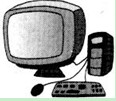问题
选择题
光通过各种不同的障碍物后会产生各种不同的衍射条纹,衍射条纹的图样与障碍物的形状相对应,这一现象说明
A.光是机械波,且可以携带信息
B.光具有波动性,且可以携带信息
C.光具有粒子性,但不可携带信息
D.光具有波粒二象性,但不可携带信息
答案
答案:B
题目分析:本题意说光通过各种不同的障碍物后会产生各种不同的衍射条纹说明光是一种波,而无法说明光是电磁波,只能说明光具有波动性而不能说明光具有粒子性.衍射条纹的图样与障碍物的形状相对应说明光可以携带信息.
A、光是电磁波,但本题题干只能说明光是一种波,而无法说明光是电磁波,故A错误.
B、既然光能够发生衍射现象,则光一定是一种波,既然是波,就具有波动性,故B正确.
C、光具有粒子性,衍射条纹的图样与障碍物的形状相对应,说明光可以携带信息,故C错误.
D、光具有波粒二象性,可携带信息,故D错误.
故选B.
点评:本题是一道不可多得的好题,告诉同学们解题或处理问题时一定要从因到果,而不能无中生有.




